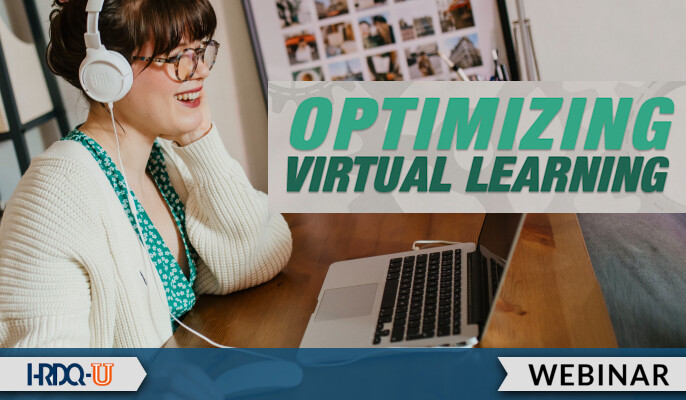One of the biggest reasons that virtual environments are not successful is the lack of engagement. In the virtual environment, we tend to drop the activities that we did in person, possibly due to the restriction of time or maybe the lack of online design experience. But here is the reality: engagement and interactivity are the most important aspects of virtual learning that must be included to create a successful virtual learning environment. We cannot be delivering asynchronously to our learners, especially now. When we are together in a live virtual environment, the content and the opportunity to learn need to be synchronous. It needs to be engaging and interactive, and it needs to have energy. Our learners are filled with distractions, probably more now than ever before. There is a lot going on in their lives, and we are fighting for that attention. But attention alone isn’t the only reason engagement is important in a virtual setting; the other reason is the social component. In the virtual learning environment, we need to leverage the opportunity to create social connections for our students. Our session might be their only time that day to connect with someone else. They may be alone most of the time – some may not have friends they can see or may not have family around. When we are connected in a virtual learning environment, for some of us, this is our only connection. Take advantage of that opportunity, establish and create opportunities to build those social connections.
Icebreakers and Energizers
The tone of your session and the success is set from the very beginning. Establishing a connection, building trust, and creating an engaging environment at the opening of the session can set us up for success and prime the learners to be involved. It’s equally important to keep that energy level consistent throughout your session. Icebreakers are a great tool to use at the beginning of your session, and energizers are a great tool to use throughout your session, especially after breaks or lunch to pull the learners back in and get them excited and energized to move forward. Icebreakers and energizers can be used interchangeably – the only real difference is we call “icebreakers” the activity at the beginning of the session to break the ice and get learners connected, while energizers are the activities we use throughout the session to keep learners engaged, give their brains a rest from content, and keep the energy level high. Here are some of my favorite icebreaker activities:
5 Icebreaker and Energizer Ideas
The Object of Me
Give learners 1 or 2 minutes to quickly find an item, wherever they are, that best represents them. Pick someone by name to share their object, and pick someone else to guess what that object says about them. Continue the activity until everyone has shared. This is a great activity to learn more about your colleagues or fellow learners. Here’s an example to show how everyone can participate regardless of where they’re located. Recently, someone asked me to participate, and I wasn’t at home. I was in a new environment, but I had just finished having breakfast. I didn’t know what could possibly represent me. And then I looked down at my plate, and I had a little piece of avocado left. And I realized I could use that – it represents me. It’s healthy, and it’s organic, and it has a little bit of good fat.
Remember Me
Find an image online, maybe one that is intricate and filled with many details. Show the image to the learners for 15 to 20 seconds. Ask everyone to look at the picture and try and memorize as much as they can. And then, after that 20 seconds, take the photo away and allow everybody to share what they saw. It’s a simple, fun activity because there’s always going to be something a little bit different that each person sees. It helps us learn a little bit more about the way our learners think.
Optical Illusion
Find a fun optical illusion picture and ask learners to describe what they see. But remember – there are no wrong answers in optical illusion photos. If that is what they are seeing, that is their reality.
Virtual Rock, Paper, Scissors.
Another fun one I have been using, both with adults and children, is Rock, Paper, Scissors. Take a few minutes, get everybody on camera, and do a tournament of rock paper scissors. It’s a really fun, old-fashioned way to get people engaged. If you have a large group, you could utilize the breakout rooms to have tournaments. Take the winner from the breakout rooms and have a final tournament in the main room. Those who are “playing” in the tournament can keep their cameras on, and those who are not can turn theirs off. This helps to easily identify who is playing.
Game Play
Games can be a great way to keep learners engaged and give them a mental break from content to reenergize. Here are some options:
- Search online for Trivia games.
- Play 2 Truths and a Lie.
- Play charades on camera.
- Pick a popular song and find a version on YouTube that is played backwards and have learners guess.
Best Practices
Ask yourself this question: When you are in a virtual setting, what is the time limit for you before you start to zone out? Maybe you pick up your phone, maybe you switch the screen. How many minutes has it taken you before that has happened? For me, it’s about five minutes. That’s my attention span when I’m not being engaged or my attention isn’t required. Whatever your answer is, that should be the baseline of how often we should be building in interactions. If we are getting bored at five minutes or seven minutes, most likely so are our participants. Practicing empathy in the virtual environment is critical for success.
3-5 minutes. This is the best practice for creating frequent interactions. And it does not need to be a complicated activity; it can be a simple call for their attention back to the screen. For this to work, though, level-set with your students at the very beginning of the session. Let them know it’s going to be interactive. For example, I have a rules of the road slide I use that covers my expectation for the conduct in the session. I clearly say, “this class requires your participation and you may be called upon.” By letting them know upfront that this is happening, I’m setting the stage so I can call on them, preferably by name, so that they are staying engaged. And that’s not in a rude or negative way. Using their name is another tip to make them feel recognized and validated,
Take into consideration the number of people in your session. The larger the group, the more challenging the activities become as more time will be required. If a session is over 20 people, consider utilizing breakout rooms for longer energizers or icebreakers. Groups over 20 are going to be designed much differently than groups under 20. Even groups of 5 people are going to be designed differently than for groups of 10 or 15 people. For example, open microphone discussions are going to be more challenging with the more people that you have. Even chat can be more challenging when you have over 20 people. So, you want to be deliberate and intentional when designing and consider the size of your audience.
In addition to icebreakers and energizers, we can use nonverbal communications to create engagement opportunities in the virtual classroom. It could be as simple as asking a question and having students type the answer in chat or click on the agree or disagree / thumbs up or thumbs down button. Nonverbal communication tools are available regardless of the platform being used and are very powerful ways for our students to continue to engage with us. When we talk about engagements needing to be every 3 to 5 minutes, it does not have to be a full-blown activity that requires you to stop teaching; it could be as simple as clicking the agree or disagree button. The idea is just to create some sort of engagement or interaction that draws them back into that virtual environment so that we can get their attention.
Remember to consider your learners in everything that we do. The most important thing that we need in this world right now is empathy, not just for our learners but for every human being. Designing and delivering with our learners in mind will help to keep them engaged and lead to successful virtual learning experiences.
















